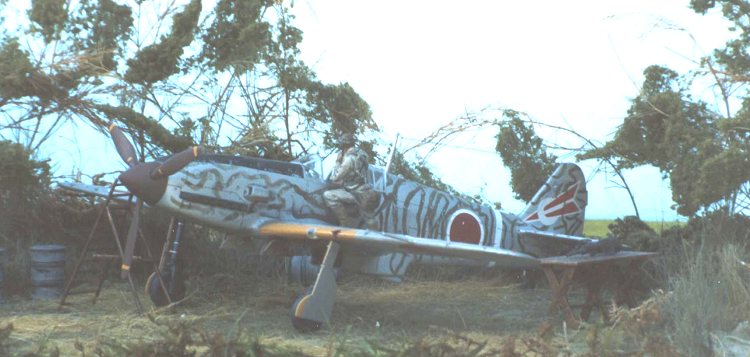
|
KIT: |
Hasegawa 1/48 Ki-61-1d |
|
KIT # |
? |
|
PRICE: |
£17 |
|
DECALS: |
See Review |
|
REVIEW & |
Andrew Johnson |
|
NOTES: |
Aeromaster decals, Aires cockpit set, Eduard canopy masks used |

|
HISTORY |
The Hasagawa Hien is the last version of the aircraft fitted
with the license made DB 601A inline V12 (Kawasaki Ha. 40). This version
introduced simplified construction to speed up production and maintenance.
Armament was two Japanese Ho. 5 20 mm cannon over the cowling and two 12.7 mm
machine guns in the wings. In the rugged field conditions of New Guinea the
aircraft was not a success due to its poor 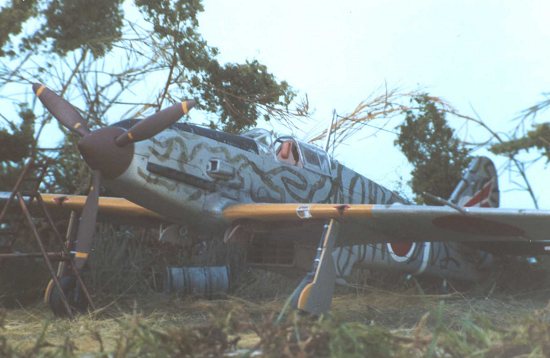 serviceability. However, unlike the
Ki-43, this was the only army aircraft that could follow the standard American
fighter evasion technique of a dive. Later in the war, fighting from the home
islands, its efficient supercharger made it the premier high altitude
interceptor. With its long span and wide track undercarriage it was probably a
safer plane to fly than its progenitor the Bf 109. American Navy test pilots
called it neat, convenient and pleasant to fly.
serviceability. However, unlike the
Ki-43, this was the only army aircraft that could follow the standard American
fighter evasion technique of a dive. Later in the war, fighting from the home
islands, its efficient supercharger made it the premier high altitude
interceptor. With its long span and wide track undercarriage it was probably a
safer plane to fly than its progenitor the Bf 109. American Navy test pilots
called it neat, convenient and pleasant to fly.
Iíve always fancied the crazy green squiggles on NMF which characterized the early Borneo Ki-61ís of the 68th Sentai. However, how could I do such a scheme for a late war Ki-61 1d? From reading the Schiffer book by Richard Bueschel on the Hien I learned that the 18th, 19th and 55th Sentais' were equipped with this version and sent to defend Luzon in October 1944. The tail marking of the 55th Sentai comes with the decals in the Hasagawa kit and the Schiffer book shows a wide variety of squiggle or blotch camouflage on these aircraft. Apparently the 55th Sentai was eliminated as a unit by the end of November 1944.
|
BUILDING, PAINTING, & DECALING |
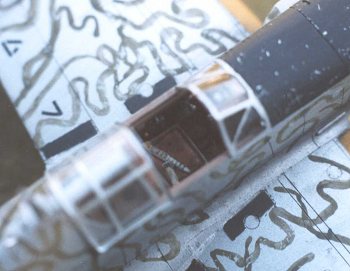 I installed the Aires cockpit set but elected to keep the kit
cowling rather than replace it with a photo-etch. This necessitated a fair bit
of sanding but was successful. There must have been quite a racket when the
trigger was pulled with the buttsí of the two cannons right in front of your
face! I separated and dropped the elevators by a few degrees. Fit of the top of
the wings to the fuselage was not that great. There is no transverse stiffener
on the wings, so as you push the wing curvature can flex, which is a bit scary
when trying to glue it to the fuselage!
I installed the Aires cockpit set but elected to keep the kit
cowling rather than replace it with a photo-etch. This necessitated a fair bit
of sanding but was successful. There must have been quite a racket when the
trigger was pulled with the buttsí of the two cannons right in front of your
face! I separated and dropped the elevators by a few degrees. Fit of the top of
the wings to the fuselage was not that great. There is no transverse stiffener
on the wings, so as you push the wing curvature can flex, which is a bit scary
when trying to glue it to the fuselage!
I mixed various paints to get what looked like a satisfactory Kawasaki tan for the interior and wheel wells. After masking the control surfaces the airframe was sprayed with SnJ aluminium. The fabric covered control surfaces were then painted with Aeromaster grey-green. The leading edge yellow and cowl blue-black were Aeromaster acrylics. The squiggly green was Aeromaster Kawasaki acrylic green thinned and hand painted. The green and cowl black were gently picked at with a cocktail stick to give the worn look.
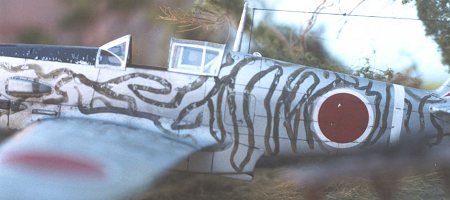 Johnsonís Clear varnish preceded the decals which were a
mixture of kit and Aeromaster. Fine fuse wire were added as brake wire to the
landing gear. The exhaust pipes were drilled out and painted Aeromaster tire
black. These can be glued on last. Aeromaster flat varnish was then used prior
to a dark oil wash and some pastels. The pilot came from the Hecker and Goros
range. Not easy to find Japanese figures for dioramas, so three cheers to Hecker
and Goros!
Johnsonís Clear varnish preceded the decals which were a
mixture of kit and Aeromaster. Fine fuse wire were added as brake wire to the
landing gear. The exhaust pipes were drilled out and painted Aeromaster tire
black. These can be glued on last. Aeromaster flat varnish was then used prior
to a dark oil wash and some pastels. The pilot came from the Hecker and Goros
range. Not easy to find Japanese figures for dioramas, so three cheers to Hecker
and Goros!
Photos of Hienís are often of the aircraft being examined by US personnel in some rough jungle clearing and this was the setting I was looking for. The vegetation is comprised of asparagus ferns set in plaster and decorated with various railroad foliage. The dispersals often seem to be areas of flat earth with the vegetation having been stamped flat, and this can be created with a cut grass product, or brush bristles set in white glue and spray-painted.
|
CONCLUSIONS |
A very attractive kit but some care needed with the wing fit. The panel lines are petite and to me just right.
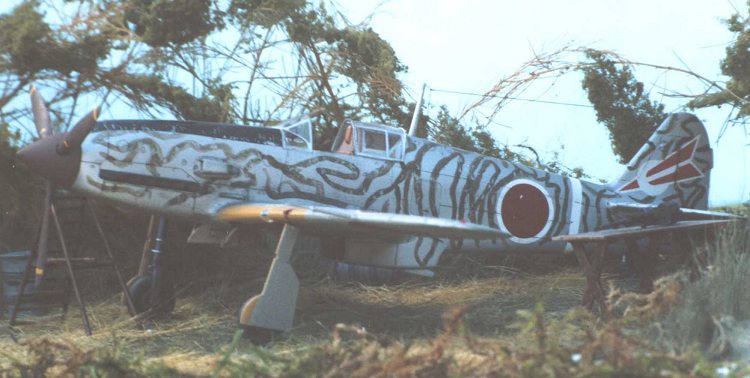
|
REFERENCES |
Japanese Army Air Force Aces 1937-45 H. Sakaida, Osprey
Aircraft of the Aces 13
Kawasaki Ki-61 Hien In Japanese Army Air Force Service, R.M. Bueschel,
Schiffer Military History
If you would like your product reviewed fairly and quickly by a site that averages over 2,400 visits a day, please contact me or see other details in the Note to Contributors.